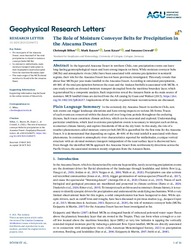The Role of Moisture Conveyor Belts for Precipitation in the Atacama Desert
DOI: https://doi.org/10.1029/2021GL094372
Persistent URL: http://resolver.sub.uni-goettingen.de/purl?gldocs-11858/9817
Persistent URL: http://resolver.sub.uni-goettingen.de/purl?gldocs-11858/9817
Supplement: https://www.crc1211db.uni-koeln.de/search/view.php?dataID=38, http://www.cr2.cl/datos-de-precipitacion/, http://explorador.cr2.cl/
Böhm, Christoph; Reyers, Mark; Knarr, Leon; Crewell, Susanne, 2021: The Role of Moisture Conveyor Belts for Precipitation in the Atacama Desert. In: Geophysical Research Letters, Band 48, 24, DOI: 10.1029/2021GL094372.
 |
Dokument öffnen: |
In the hyperarid Atacama Desert in northern Chile, rare precipitation events can leave long‐lasting geomorphological traces and have strong impacts on biota. While moisture conveyor belts (MCBs) and atmospheric rivers (ARs) have been associated with extreme precipitation in semiarid regions, their role for the Atacama Desert has not been previously investigated. This study reveals that about four MCBs per year make landfall in the Atacama Desert. According to simulated precipitation, 40–80% of the total precipitation between the coast and the Andean foothills is associated with MCBs. A case study reveals an elevated moisture transport decoupled from the maritime boundary layer, which is generalized by a composite analysis. Back trajectories reveal the Amazon Basin as the main source of moisture. MCB landfall times are derived from the AR catalog by Guan and Waliser (2015), https://doi.org/10.1002/2015jd024257. Implications of the results on paleoclimate reconstructions are discussed. Plain Language Summary:
In the extremely dry Atacama Desert in northern Chile, rare rain events can trigger landscape alterations and have strong impacts on various life forms. Traces of such events are conserved within the desert soil over long time periods throughout the enduring dryness. Such traces constitute climate archives, which can be excavated and explored. Understanding particular conditions, which lead to extreme precipitation events is necessary to interpret such archives, reconstruct climate history, and explore thresholds of life at the dry limit. In this study, the role of a weather phenomenon called moisture conveyor belt (MCB) is quantified for the first time for the Atacama Desert. It is demonstrated that depending on region, 40–80% of the total rainfall is associated with these phenomena. In contrast to atmospheric river characteristics reported for midlatitudes, a unique vertical structure with an elevated moisture transport independent of the near‐surface layer is discovered here. Even though the identified MCBs approach the Atacama Desert from northwesterly directions across the Pacific Ocean, the associated moisture mostly originates from the Amazon Basin. Key Points:
For most parts of the Atacama Desert, more than half of the total precipitation is related to moisture conveyor belts (MCBs).
In contrast to midlatitudes, main moisture transport takes place in mid‐tropospheric layers decoupled from the maritime boundary layer.
The main origin of the MCB‐related moisture is found to be the Amazon Basin.
Statistik:
ZugriffsstatistikSammlung:
This is an open access article under the terms of the Creative Commons Attribution License, which permits use, distribution and reproduction in any medium, provided the original work is properly cited.

